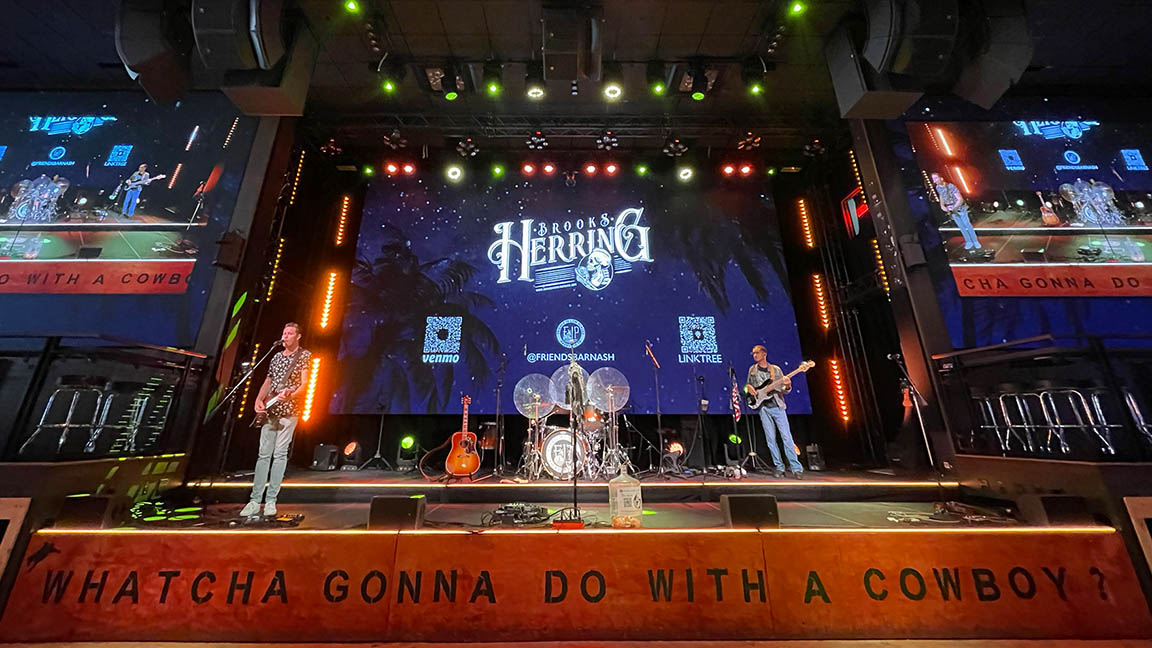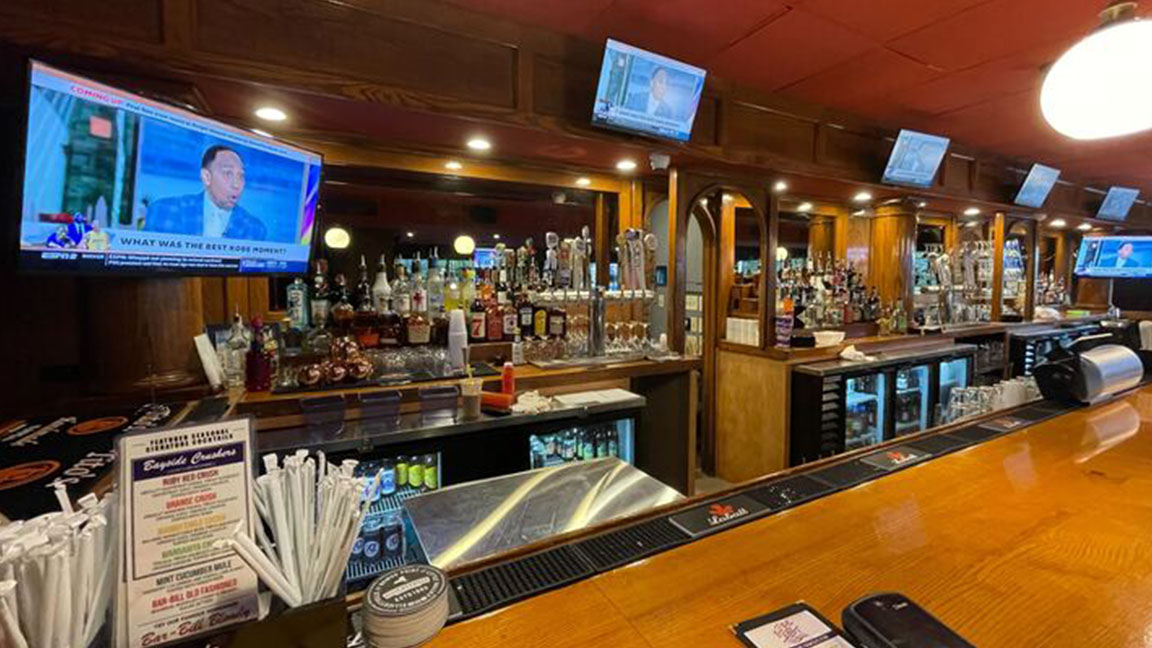A Night on the Town
Pro AV takes center stage in sports bars and live music venues.

The sports bar evolution has come a long way in the past two decades. It has gone from having the most TVs to larger, higher-definition displays and immersive, zoned sound. What were once luxuries have become necessities for any sports bar—or live music venue, for that matter—to survive.
[Wireless Microphone Headaches]
While buffalo wings and burgers are enticing, anyone who prefers sports bars for their game-day watching pleasure knows it’s all about the ability to see and hear your team in action. That's why technology—from devices and software to control systems—is more important than ever.
Pitchers and Pictures
Today's sports bar is nothing without programming. If you have a football Sunday where the audio isn’t zoned properly or the displays aren’t top shelf, those fanatics are finding a new sports bar the following week. That's why it is imperative to get it right the first time. Paul Harris, CEO/CTO at Aurora Multimedia, offered up a checklist of best practices for audio and video distribution setup in a venue that specializes in showing sports and live music.
• Location, Location, Location: Consider seating locations, as people will be facing a variety of directions, not to mention obstacles like columns that can be in the way. The number of displays, placement of displays, and sizes of the displays will be based on location to make the customers experience a pleasant one. Selecting the right size is based on viewing distances, considering the closest to furthest away—too big and it will be difficult for closer patrons to view, while too small makes creates an issue from viewers located further away.
• Even Audio: Projecting audio across the room will only make it more difficult to hear at a distance and uncomfortable if someone is positioned closer to the speaker—plus, having a conversation will become frustrating.
• Seamless Switching: When switching between live and broadcast, it's important to use seamless switching for a clean change in content. Zero latency is also critical, so the customer does not see the time difference between when the performer speaks and what is seen. Having a good DSP processor for mixing and feedback suppression is key, as no one wants an unpleasant squeal from the speakers.
A daily selection of the top stories for AV integrators, resellers and consultants. Sign up below.
Digging a little deeper, in a world where IP-based solutions are taking over, what works best: RF, AVoIP, a hybrid approach, or something else? Scott Hetzler from Contemporary Research posed that RF or hybrid may be the best-case scenario in most instances. An RF system takes advantages of tuners built into most TVs, eliminating the need for external hardware IP decoder boxes. Instead, a simple IR or RS-232 controller operates over the same coax cable.
“The cost of an RF system with full TV control is approximately 40% less than an AVoIP system,” Hetzler explained. “CR offers a package system called Venue Vizion available in RF/hybrid or IP. These packages are pre-wired and ready to drop into a rack, and come with modulators or encoders for eight channels, and controllers or decoders for up to 20 TVs. These packages make installation easier and lower cost, but can easily be expanded for more channels or TVs and offer complete TV control from any web-enabled device such as pad, phone, or PC.”
Amped for the Action

While even audio is important, so is the clarity and quality of the sound itself. Which loudspeakers are best in a sports bar environment?
Patrick Nunnally, AtlasIED's regional sales manager, Southeast, said there’s no one-size-fits-all for any application, including sports bars. Sometimes it depends on specific zones or the venue’s size, while other times it's a matter of background versus foreground music.
“In sports bars, this varies. The venue itself and its architecture, combined with the customer's needs and wants, will really dictate and hopefully drive you to the correct speaker choice,” Nunnally said. “We’re seeing more and more of them have an open architecture, which leads to more pendant or surface-mount type speakers aimed down. This is good because it increases your capabilities to deliver a more robust sound. My favorite for sports bars is a surface-mount speaker mounted up into the ceiling, aiming down, proportionally spaced out, and zoned out accordingly.”
“If you have all the games playing at once and they’re all competing for audio, it creates a bad experience for everyone and can drive customers away.”
Patrick Nunnally, AtlasIED
As Nunnally recollected, based on his 30 years of experience in sports bars as both a patron and integrator, some people initially want to have audio from every TV all over the place. In reality, this can make the environment chaotic and unpleasant. “It’s best to establish a hierarchy based on the time of day and the events taking place,” he said. “If you have all the games playing at once and they’re all competing for audio, it creates a bad experience for everyone and can drive customers away.
[A Winning Bet in Downtown Hartford]
"When there are no sports events, you could have background music playing throughout the facility. But when important games, like college or NFL football, are happening simultaneously, you need to prioritize which game will be the main focus. You can then allocate a separate zone for specific groups of supporters.”
Many sports bars serve as venues requiring live sound as well, whether it be trivia night or a band on the patio. It’s important to engineer the system to handle the demands of live audio, as it is the most challenging aspect. “The key is choosing speakers that fit the ceiling heights and customer preferences and then designing the system around them,” Nunnally said. “Once you find the ideal speakers, everything else, including amplification and digital signal processing, can be selected to match.”
Livin’ on a Prayer

Garth Brooks and Trisha Yearwood held the grand opening of their 55,000-square-foot Friends In Low Places Bar & Honky-Tonk in March. It offers plenty of screens for watching sports, as well as a full bar and plenty of bar eats, but its main focus—as you might suspect considering the owners—is live music.
The venue is using an L-Acoustics A Series concert sound system, designed by Clair Global Integration. On each side of the stage are one A15i Focus over two A15i Wide enclosures, and another hang of one A15i Focus over two A15i Wide to provide even coverage up to the second-level balcony. A DiGiCo Qauntum225 console provides front-of-house and monitor mixes for four bands a day.
Meanwhile, The Oasis, a rooftop bar, has its own A Series loudspeakers and KS21i subwoofers powered by an LA4X amplified controller. “One of our mantras at Clair is it has to sound great, not just loud,” explained Joe Anderson, systems designer. “Our goal is to elevate the production-value level of the entire sound experience here, making it closer to what you’d expect from a concert rather than a club. The A Series speakers deliver great sound, with a lot more punch than you’d expect from their size, right out of the box."
Another Nashville live-music venue is JBJ’s Nashville, owned by music legend Jon Bon Jovi. It requires much of the similar technology required in a sports bar. There are a multitude of displays and, of course, the sound is of vital importance in a restaurant/bar dubbed the “state-of-the-art fusion of rock 'n' roll and country.” Last summer, Aurora Multimedia was called upon to integrate multiple networks at the venue.
Aurora Multimedia went with its 1G AVoIP VPX Series at JBJ’s Nashville thanks to its seamless switching and enhanced image quality with zero-frame latency. Per Harris, the VPX Series offers Bluetooth Auracast and software-based Dante/AES67. Paired with IPBaseT Manager—Aurora’s enterprise class management software—users can route video previews, make macros, create alerts, and more on any PC, tablet, or phone.
“When you have a facility that must be on the top of its game, there is no time for downtime,” Harris said. “The VPX Series are all transceivers … they can be set as an encoder or decoder as required. In addition, the units have self-healing features and live diagnostics. These diagnostics can remotely tell the support person if the issue is the equipment, customer usage, or connected equipment related, and at what day and time it occurred.”
Sign of the Times
Digital signage? In a sports bar? Believe it or not, Brian Rowley, chief marketing officer at BrightSign, is seeing a much-needed use for digital signage and display solutions. Sports bars are frequented by those fans that can't make it to the stadium, so massive video walls can substitute for that experience.
"Video walls powered by digital signage players stream games in 4K resolution, making guests feel as if they are at the game," explained Rowley. "Meanwhile, to elevate the fan experience, digital signage displays positioned adjacent to video walls promote game-time specials, the latest menu offerings, breaking news, and even pictures of patrons who want to share their fandom with others. When a game is happening, sports bars need to keep fans engaged and in the moment, while bringing in the social and communal elements sports fans crave."
[The Digital Signage Best Practices Guide]
The right digital media players and signage technology give sports bars more flexibility, enabling them to switch things up during breakfast or lunch times by providing what Rowley calls a blank canvas to create their vibe and promote specials, menu items, or advertisements. "The BrightSign XT5 Digital Player is popular for sports bar settings for its strong dual-screen performance, superior live-streaming capabilities, and hassle-free content control—all using a single player," Rowley said. "It offers the right blend of motion graphics power and video performance to make guests feel as if they are present at the game in person. With 8K video and 3D motion graphics capabilities, the XT5 creates dynamic visuals that immerse guests into the experience."
Game-Day Control
Welcome to Bar-Bill Tavern, which has multiple locations across upstate New York in Clarence, East Aurora, and Rochester. The system at Bar-Bill Tavern was antiquated, using multiple remotes to control the audio and video like the “old days” of sports bars. Systems integration firm Park Place Installations looked to simplify the control at all the Bar-Bill locations and to do that, it turned to Snap One’s Control4.

Sports-bar friendly, Control4’s Simple Device Discovery Protocol (SDDP) technology enables hassle-free setup and seamless integration with over 20,000 devices. This makes day-to-day operations far more efficient by controlling everything from one centralized platform.
Scott Normand, commercial market senior director for Snap One, said the MultiDisplay Manager feature is ideal in a restaurant or sports bar. It allows easy control of hundreds of displays across multiple rooms, keeping patrons engaged by ensuring they can watch the games or programs they want.
“Control4 is an ideal solution for restaurants and sports bars looking for simplified AV control combined with intuitive features,” Normand added. “It's beautifully designed interface allows end users to manage complex AV systems effortlessly with minimal training, ensuring smooth operation.”
No matter what solution you go with in the sports’ bar space, much like a Rob Gronkowski playbook, the simpler the better. “From our experience in the restaurant and sports bar industries, we’ve learned that both integrators and end users prioritize simplicity,” Normand explained. “Integrators want a system that’s easy to install and program, and end users want a system that’s intuitive and easy to operate. In a fast-paced environment such as a sports bar, a simple-to-operate system allows for employees to quickly change displays to the most relevant game, monitor light settings, or play a victory song over the audio system when a key win is secured.”

Wayne Cavadi is the senior content manager of Systems Contractor News. Prior to taking a leap into the Pro AV industry, Wayne was a journalist and content lead for Turner Sports, covering the NCAA, PGA, and Major and Minor League Baseball. His work has been featured in a variety of national publications including Bleacher Report, Lindy's Magazine, MLB.com and The Advocate. When not writing, he hosts the DII Nation Podcast, committed to furthering the stories and careers of NCAA Division II student-athletes. Follow his work on Twitter at @WayneCavadi_2 or the SCN mag Twitter page.
